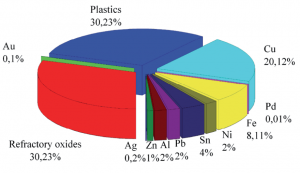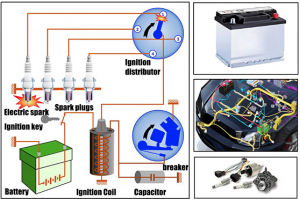Lesson 4 – WEEE Recycling Processes
Welcome to fourth lesson of our online course on WEEE recycling processes. In this course, we will explore a variety of WEEE recovery and recycling processes that allow the recovery of large quantities of reusable products.
Recycling WEEE – whatever you call it, is a growing opportunity for recyclers around the world as the amount of waste and the need for resources increases. As we know WEEE is composed of metal (40%), plastic (30%) and refractory oxides (30%). As shown in the figure below, typical metal scrap consists of copper (20%), iron (8%), tin (4%), nickel (2%), lead (2%), zinc (1%), silver (0.02). %), gold (0.1%) and palladium (0.005%). Polyethylene, polypropylene, polyesters and polycarbonates are typical plastic components.
Material composition of WEEE [S. Sodhi, B. Reimer, Models for recycling electronics end-of-life products, OR Spektrum, 23 (2001) 97-115]
To know what are the parts and EEE of an ELV, we must first know how the electrical system of a car works. Thus, the on-board network of the car is the power network of the car that connects the sources and consumers of electrical energy. The sources of electrical energy in the on-board network are a generator and a storage battery (battery).
Thus, the main consumers of automotive electricity are: Accumulator by charging; The field generator; Automotive ignition system; Headlamps and position lamps of a car; Alarm; Fans, heated seats and windows; Car audio system; Switchgear, distribution and protection devices; Safety support; Buttons, switches and switches, relays; Switch and power blocks; Car wiring, etc.
We will make a brief description of the consumers of a motor vehicle:
The electrical system of the car is designed to generate and transmit electrical energy to various systems and WEEE of a car: 1. current supply sources, 2. current consumers, 3. control elements and 4. electrical wiring.
The electrical system [https://www.newkidscar.com/electrics/how-a-cars-electrical-system-works/]
All these components of the electrical system are connected to a single “vehicle network”:
- Power supplies provide power to the various systems and devices of the car to run smoothly and efficiently. These sources being: Battery and Generator.
- Current consumers include the following automotive systems: Ignition system, Starting system, Lighting system
- 3. Control elements include: Electronic Control Units (ECU), PCB, Fuse Boxes, Relay Blocks.
- Electrical wiring. Wiring is one of the first components to be assembled in a vehicle.
If, for example, wiring is to be removed, the vehicle must be 75% dismantled. In addition, the wiring of a vehicle is very branched, therefore, removing the wiring means completely disassembling the vehicle – a very complex and time-consuming process.

